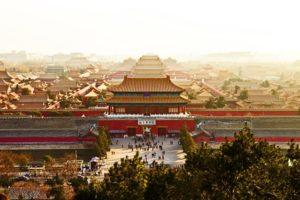Fodor's Expert Review Jietai Temple
The four main halls of one of China's most famous ancient Buddhist sites occupy terraces on a gentle slope up to Ma'an Shan (Saddle Hill), 35 km (22 miles) west of Beijing. Built in AD 622, the temple has been used for the ordination of Buddhist novices since the Liao Dynasty. The temple complex expanded over the centuries and grew to its current scale in a major renovation conducted by devotees during the Qing Dynasty (1644–1912). The temple buildings, plus three magnificent bronze Buddhas in the Mahavira Hall, date from this period. There's also a huge potbellied Maitreya Buddha carved from the roots of what must have been a truly enormous tree. To the right of this hall, just above twin pagodas, is the Ordination Terrace, a platform built of white marble and topped with a massive bronze statue of Shakyamuni Buddha seated on a lotus flower. Tranquil courtyards, where ornate stelae and well-kept gardens bask beneath a scholar tree and other ancient pines, add to the temple's beauty.... READ MORE
The four main halls of one of China's most famous ancient Buddhist sites occupy terraces on a gentle slope up to Ma'an Shan (Saddle Hill), 35 km (22 miles) west of Beijing. Built in AD 622, the temple has been used for the ordination of Buddhist novices since the Liao Dynasty. The temple complex expanded over the centuries and grew to its current scale in a major renovation conducted by devotees during the Qing Dynasty (1644–1912). The temple buildings, plus three magnificent bronze Buddhas in the Mahavira Hall, date from this period. There's also a huge potbellied Maitreya Buddha carved from the roots of what must have been a truly enormous tree. To the right of this hall, just above twin pagodas, is the Ordination Terrace, a platform built of white marble and topped with a massive bronze statue of Shakyamuni Buddha seated on a lotus flower. Tranquil courtyards, where ornate stelae and well-kept gardens bask beneath a scholar tree and other ancient pines, add to the temple's beauty. Many modern devotees from Beijing visit the temple on weekends. Getting to Jietai and the nearby Tanzhe Temple is easy using public transportation. Take subway Line 1 to its westernmost station, Pingguoyuan. From there, take the No.931 public bus to either temple—it leaves every half hour and the ride takes about 70 minutes. A taxi from Pingguoyuan to Jietai Temple should be Y50 to Y60; the bus fare is Y6.
READ LESS







